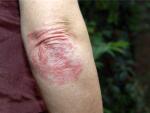What is maculopapular rash?

A rash is a symptom of numerous conditions. Doctors describe rashes referring to the types of lesions they display. The term “maculopapular” is one such description. It is “nonspecific,” which is a general term for what a rash looks like, not a particular condition or cause.
Other names for maculopapular rashes include exanthematous eruption or reaction and morbilliform eruption or rash.
What does a maculopapular rash look like?
Maculopapular rashes are widespread. They usually start acutely or suddenly and can be itchy. The name tells you what it looks like.
A macule is a flat, defined lesion that is 1 centimeter (cm) or less in diameter. A papule is a raised, defined lesion of the same diameter. A maculopapular rash has both of these characteristics. The lesions are typically pinkish, reddish, or discolored. They form an erythematous maculopapular skin rash.
A maculopapular rash is usually not scaly and does not have pimples, blisters, or fluid-filled vesicles.
What causes a maculopapular rash?
Maculopapular rashes are common and there are several potential causes. In a maculopapular rash differential diagnosis, the two main causes are drug reactions and viral infections.
Almost any drug can cause a diffuse maculopapular rash. In fact, maculopapular rashes are the most common skin reactions to drugs. The timing is usually within 7–10 days after starting a new medication. However, this can range up to 4 weeks. These drug rashes often start on the trunk or close to it on the extremities.
The drugs most likely to cause maculopapular rashes include:
- allopurinol (Zyloprim)
- angiotensin-converting enzyme inhibitors
- antiseizure medications, such as carbamazepine (Tegretol) and phenytoin (Dilantin)
- beta-lactam antibiotics, such as penicillins and cephalosporins
- hypoglycemics, such as sulfonylureas
- nonsteroidal anti-inflammatory drugs
- sulfonamides
- thiazide diuretics
Viral maculopapular rashes usually start with flu-like symptoms. The symptoms include fever, fatigue, headache, or diarrhea. The rash appears later, typically starts at the top of the body, and spreads downward. Having an underlying viral infection makes a drug reaction more likely.
Viral infections that commonly cause maculopapular rashes include:
How do you diagnose maculopapular rash?
To diagnose the cause of a maculopapular rash, your doctor will take a medical history and perform an exam. Your age and symptoms can be big clues to the cause.
Viral infection causes are more common in children. Flu-like symptoms will support this diagnosis.
Adults are more likely to have a drug reaction. New medications within the last month are considerations for a cause.
Usually, testing is not necessary. However, doctors may order the following:
- antibody tests for viruses
- complete blood count to check white blood cells
- liver and kidney function tests
How do you treat a maculopapular rash?
If the cause is a drug, treatment involves stopping it if possible. Viral infections that cause maculopapular rashes are self-limited.
To help relieve the rash, doctors may recommend the following:
- oral antihistamines
- topical corticosteroid creams and other topical soothing creams
- wet wraps
What are some conditions related to maculopapular rash?
Maculopapular rashes are most likely related to a drug reaction or a viral infection.
How can you prevent maculopapular rash?
It is not always possible to prevent a maculopapular rash. When starting a new drug that can cause a rash, it is important to be vigilant for symptoms of a reaction. If you have a reaction to a particular drug, make sure to update your medical record with all your doctors and your pharmacist.
For viral infections, contact your doctor if a rash develops.
What are the potential complications of a maculopapular rash?
Maculopapular rashes usually resolve when you stop the drug or as the viral infection subsides. The skin surface may peel as the rash fades over 1 or 2 weeks.
With continued use of a medication causing a maculopapular rash, it is possible for the rash to progress and cover the whole body. This is erythroderma and may require hospitalization.
Frequently asked questions
Here are some questions people often ask about maculopapular rashes.
Does maculopapular rash occur with COVID-19?
It is possible that a maculopapular rash can be a symptom of COVID-19. In
Are there different types of maculopapular rashes?
The general term that describes the way a rash looks is “maculopapular.” There can be different causes of the rash, including drug reactions and viral infections.
Summary
Maculopapular rashes are common. They consist of macules, which are flat, defined lesions, and papules, which are raised, defined lesions.
The rash often appears rapidly, is reddish or discolored, and may itch. The two most common causes are drug reactions and viral infections. A maculopapular rash should resolve over the course of a couple of weeks.





















